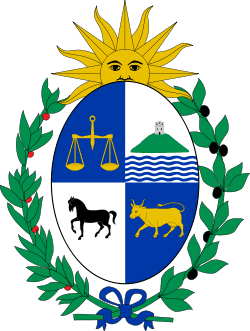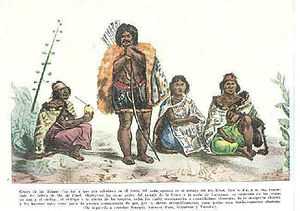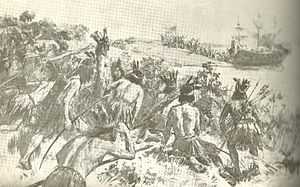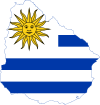Charrúa people
|
Charrúa attack on Juan Diaz de Solis expedition in Rio de la plata | |
| Total population | |
|---|---|
| extinct as a tribe | |
| Regions with significant populations | |
|
| |
| Languages | |
| Charruan languages | |
| Religion | |
| Animism |
Part of a series on the |
|---|
| History of Uruguay |
 |
|
Early History
|
|
Independent State |
|
20th Century
|
|
Military Regime |
|
Modern Uruguay
|
| Uruguay portal |
The Charrúa were an indigenous people of South America in present-day Uruguay[1] and the adjacent areas in Argentina (Entre Ríos) and Brazil (Rio Grande do Sul).[2][3] They were a semi-nomadic people that sustained themselves through fishing, hunting, and gathering.
History

It is thought that the Charrúa were driven south into present-day Uruguay by the Guaraní people around 4000 years ago.[4]
The Charrúa killed Spanish explorer Juan Díaz de Solís during his 1515 voyage up the Río de la Plata. Following the arrival of European settlers, the Charrúa were progressively killed by or integrated into the prevailing colonial cultures.
Most of the remaining Charrúa people were massacred at Salsipuedes (meaning "Get-out-if-you-can") Creek on 11 April 1831 by a group led by Bernabé Rivera, nephew of Fructuoso Rivera who was at that time the first president of Uruguay. Bernabé Rivera had invited the Charrúas to a meeting, then ambushed them. Rivera's forces slew the men and enslaved the women and children.[2] Only a few escaped this massacre.[3] That massacre was followed four months later by another led by Rivera in Mataojo.[3]
Four surviving Charrúas were captured at Salsipuedes. They were Senacua Sénaqué, a medicine man; Vaimaca-Pirú Sira, a warrior; and a young couple, Laureano Tacuavé Martínez and María Micaëla Guyunusa. All four were taken to Paris, France, in 1833, where they were exhibited to the public. They all soon died in France, including a baby daughter born to Sira and Guyunusa, and adopted by Tacuavé.[2] The child was named María Mónica Micaëla Igualdad Libertad by the Charrúas, yet she was filed by the French as Caroliné Tacouavé.[5][6] A monumental sculpture, Los Últimos Charrúas was built in their memory in Montevideo, Uruguay.[7]
Legacy

Not much is known about the Charrúa due to their eradication at an early time in Uruguayan history. The only surviving documents that concern the Charrúa are those of Spanish explorers.
Uruguayans refer to themselves as "charrúas" when in the context of a competition or battle against a foreign contingent. In situations in which Uruguayans display bravery in the face of overwhelming odds, the expression "garra charrúa" (Charrúan tenacity) is used to refer to victory in the face of certain defeat.
After Salsipuedes, the Charrúa effectively ceased to exist as a nation. It is believed that there are no full-blooded Charrúa remaining, though physical and genetic traces are found amongst Uruguay's population. According to the Argentine census of 2001, there are 676 Charrúa (the majority of whom are of mixed ancestry) living in the province of Entre Ríos.
There is a Charrúa cemetery located in Piriápolis in the Maldonado Department.[8]
The Uruguay national football team is nicknamed "Los Charrúas" and a local rugby side in Porto Alegre are also named after the nation (see: Charrua Rugby Clube)
Charrua is also a name of a Brazilian military tank for troops transportation.
In 1888 was published Tabaré, an epic poem by Juan Zorrilla de San Martín about a Charrúa and his love for a Spanish woman.
The rivuline Austrolebias charrua was named after them.
A street of Montevideo in the neighbourhoods of Pocitos and Cordón is named Charrúa.
See also
Notes
- ↑ Renzo Pi Hugarte. "Aboriginal blood in Uruguay" (in Spanish). Raíces Uruguay. Retrieved 2 February 2015.
- ↑ 2.0 2.1 2.2 Burford 16
- ↑ 3.0 3.1 3.2 "Uruguay and the memory of the Charrúa tribe." The Prisma. 28 March 2011. Retrieved 20 Dec 2011.
- ↑ Burford 12
- ↑ "El Parto de María Micaëla Guyunusa". chan-taekwondo-charrua (in Spanish). Charruas del Uruguay, LA NACION CHARRUA. May 21, 2012. Retrieved 16 December 2012.
- ↑ "El Nacimiento de Caroliné Tacouavé" (in Spanish). Retrieved 2012-06-24.
- ↑ Burford 119
- ↑ Burford 173
References
- Burford, Tim. Uruguay. Bucks, UK: Bradt Travel Guides, 2011. ISBN 978-1-84162-316-0.
External links
- Charrúa artwork, National Museum of the American Indian
| ||||||||||||||||||||||||

